10. Connecting Devices to Your MacBook
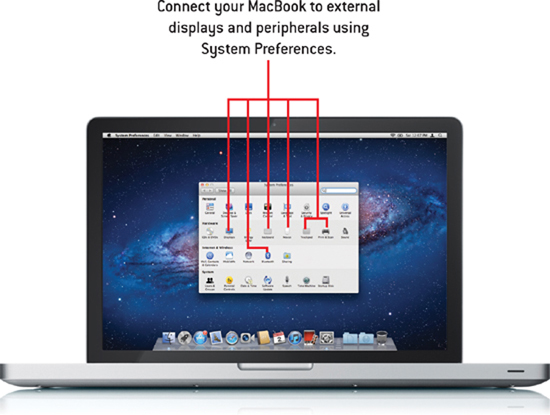
In this chapter, you’ll learn how to connect devices to your MacBook and immediately add new capabilities through Lion’s built-in features, including
• Adding a keyboard and mouse
• Pairing bluetooth devices
• Connecting and configuring external displays
• Adding and using printers
• Accessing and using popular scanners
Introduction
It isn’t unusual nowadays for a MacBook to serve both as a laptop and as a desktop computer. When you’re using the MacBook as a desktop computer, you might want to connect traditional input and output devices that are appropriate for desk or table use, such as keyboards and mice.
Your MacBook can interface to many different devices and even works with them without requiring that additional software be installed. This ease of configuration makes the transformation between desktop workstation and laptop truly a matter of seconds.
Connecting USB Input Devices
The MacBook can connect to a variety of devices using the standard USB (Universal Serial Bus) connectors located on the side of the MacBook. This section walks you through connecting a generic keyboard and mouse. Keep in mind, though, that there are hundreds of different input devices.
You should always refer to the manual that came with your device. If the manual doesn’t mention the Macintosh (such as for a Windows-specific keyboard), try plugging in the device to see what happens!
Configuring a USB Keyboard
Your MacBook has a perfectly usable keyboard, but if you’re typing for long periods of time at a desk, you might want to connect a standard desktop keyboard. To use a USB keyboard with your MacBook, follow these steps:
1. Plug the keyboard into a free port on your MacBook.
2. If the keyboard is an Apple or Mac-specific keyboard, it is recognized and immediately usable.
3. If you are using a generic USB keyboard, the Keyboard Setup Assistant launches and you are asked to identify the keyboard. Click Continue.
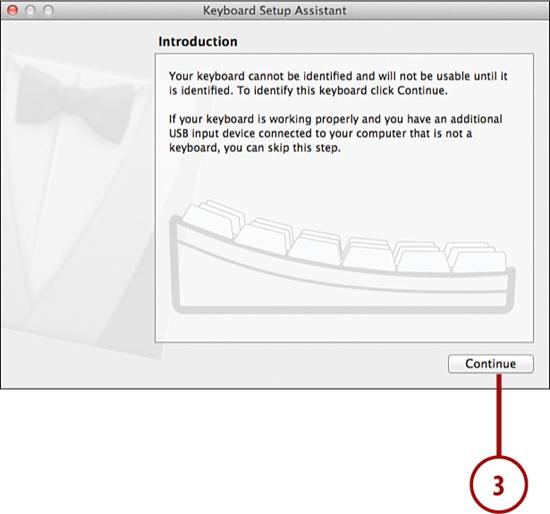
4. Walk through the steps presented by the setup assistant, pressing the keyboard keys when requested. If the assistant can’t identify the keyboard, you will be asked to manually identify it.

5. Click Done at the conclusion of the setup assistant. The keyboard setup is complete and ready to be used.
Configuring a USB Mouse
A mouse is a virtual necessity for desktop computing. Even though your MacBook doesn’t come with a mouse, it does have a Mouse System Preference Panel that you can use to quickly configure most USB mice.
1. Open the System Preferences and click the Mouse icon.
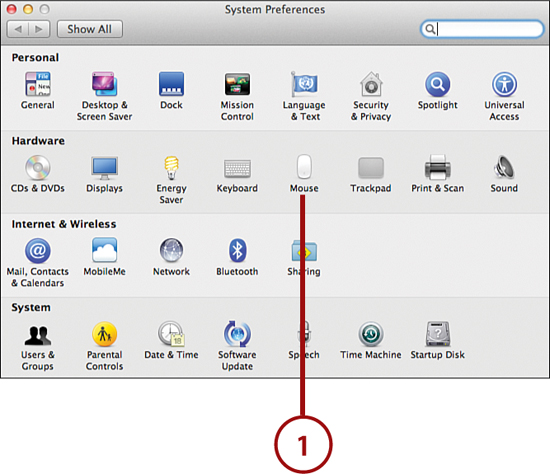
2. Plug a USB mouse into your MacBook.
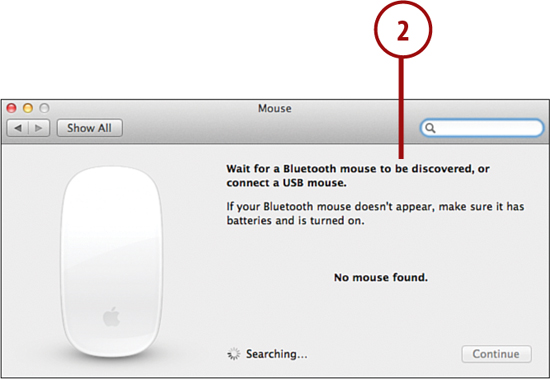
3. After a few seconds the Mouse panel updates to show the available options for your device.
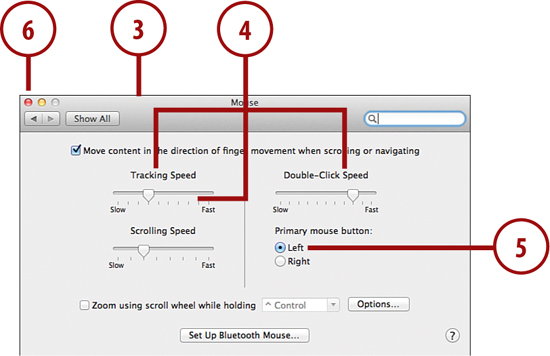
4. Adjust the tracking speed, scrolling speed (if the mouse includes a scroll wheel), and double-click speed by dragging the sliders left or right.
5. Choose which button acts as the primary button.
6. Close the Mouse panel when you’ve finished your configuration.
Using Bluetooth Devices
The MacBook’s built-in Bluetooth enables it to wirelessly connect to a variety of peripheral devices, including keyboards, mice, headsets, and so on. As with USB peripherals, your first step toward installing a device is to read the manufacturer’s instructions and install any drivers that the device comes with.
After installing any software that came with the peripheral, you use the Apple Bluetooth System Preference panel to choose and pair your device.
Pairing a Bluetooth Mouse or Trackpad
To pair a Bluetooth device with your MacBook, you follow the same basic steps, regardless of the type of peripheral. This task’s screenshots show an Apple Magic Trackpad being paired with the MacBook.
1. Open the Bluetooth System Preferences panel.

2. Click On to ensure that your MacBook’s Bluetooth system is enabled.
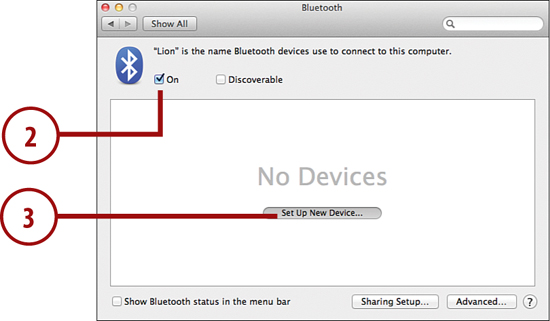
3. Click Set Up New Device, or click + below the list of devices you added previously to start the Bluetooth Setup Assistant.
4. After a few seconds of searching, nearby devices are listed. Click to choose your device from the detected options.
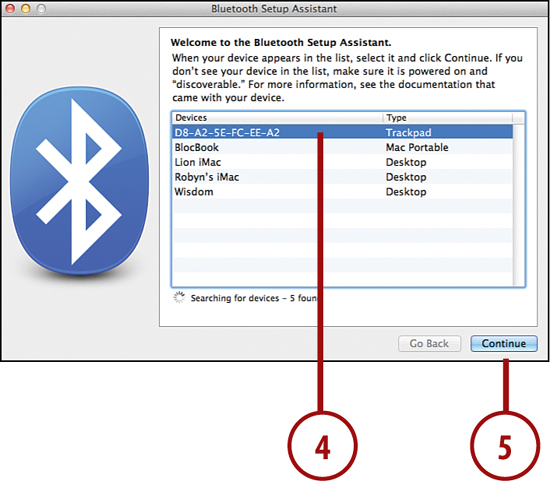
5. Click Continue.
6. The trackpad is configured and paired to your system. Click Quit to exit the Assistant.
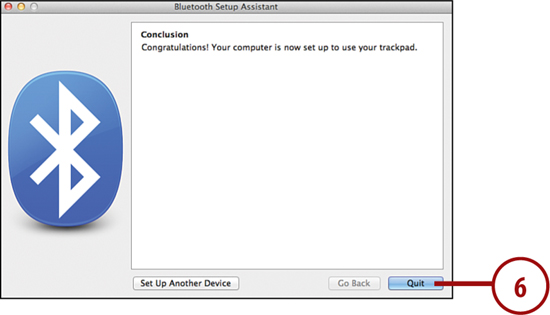
7. Your new device is listed in the Bluetooth System Preferences panel.

8. Use the corresponding (Mouse/Keyboard/Trackpad) Preference panel to configure your device.

Pairing a Bluetooth Keyboard
Some Bluetooth devices, such as keyboards, require an additional step while pairing: the entry of a passkey on the device you are pairing with. To pair a keyboard with your system, follow these steps:
1. Follow Steps 1–5 of the “Pairing a Bluetooth Mouse or Trackpad” task, selecting the keyboard device from the list of detected devices, then clicking Continue.

2. The Bluetooth Setup Assistant prompts you to enter a passkey on your device. Type the characters exactly as displayed on screen, including pressing Return, if shown.
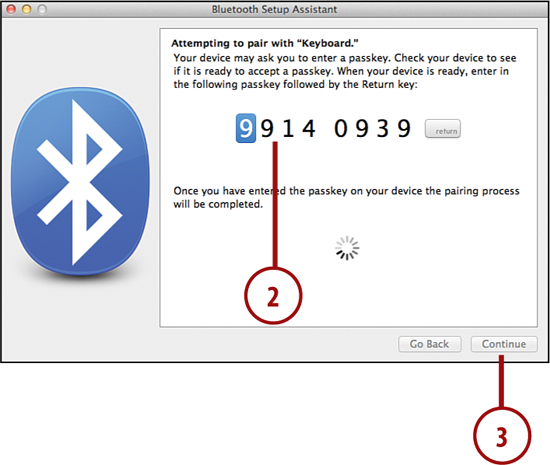
3. Click Continue.
4. If the passkey was successfully entered, the device is configured and paired.
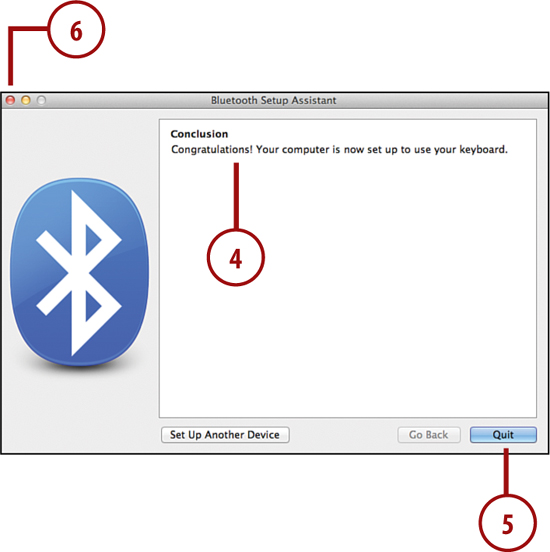
5. Click Quit to exit the Setup Assistant.
6. Close the Bluetooth System Preferences panel and configure the device as described in Chapter 9’s section “Updating Keyboard Settings.”
Connecting a Bluetooth Headset
Wireless headphones and headsets can help untether us from our computers when conferencing or listening to music. As a MacBook owner, you’re already aware of the freedom provided by a portable computer, so a wireless headset is a logical next step.
1. Follow Steps 1–5 of the “Pairing a Bluetooth Mouse or Trackpad” task, selecting the headset device from the list of detected devices, then clicking Continue.

2. The headset is added to your system. You might need to cycle the power on and off the headset before it will work, however.
3. Click Quit to exit the Setup Assistant.
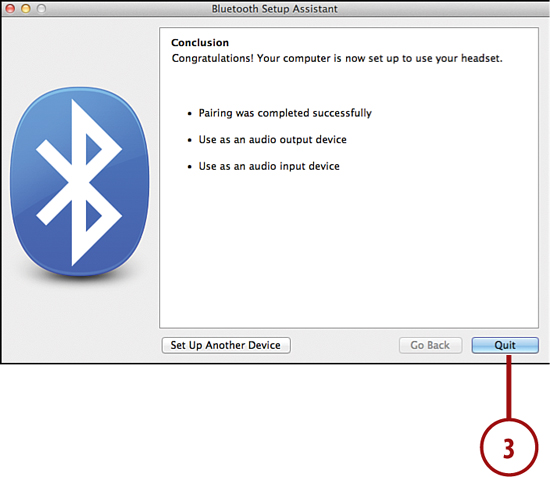
4. To set the headset for audio input or output, use the Sound System Preference panel, as described in the Chapter 9 section, “Setting Sound Input and Output.”

Adding and Using the Bluetooth Status Menu
Apple Bluetooth devices report their status directly to your computer, giving you a heads up on battery issues and other status problems. To use the Bluetooth status menu, follow these steps.
1. Open the Bluetooth System Preferences window and click the Bluetooth icon.
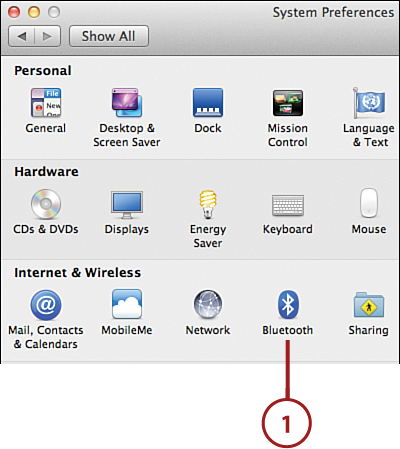
2. Click the Show Bluetooth Status in the Menu Bar checkbox.
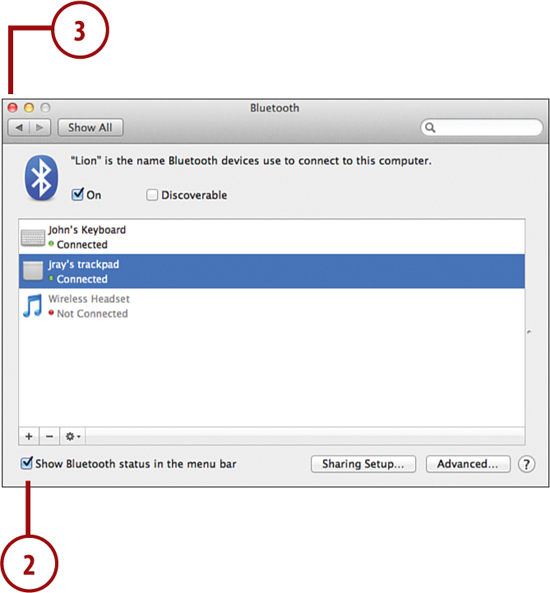
3. Close the System Preferences.
4. The Bluetooth menu is added to your display.
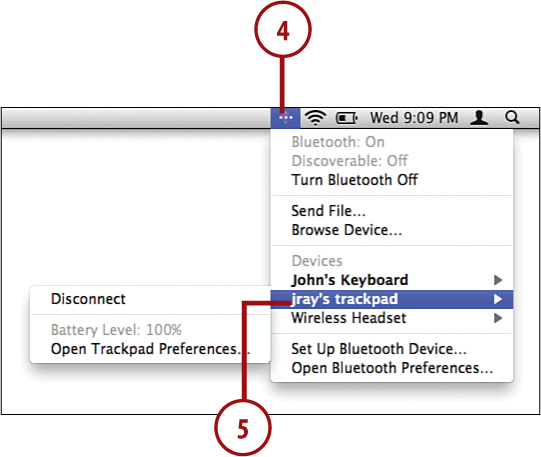
5. Each paired device has an entry in the menu for quick control of its features.
Using External Displays and Projectors
The MacBook screen sizes range from 11″ to 17″, which is plenty of room for most applications. There are times, though, when using an external monitor or a projector are helpful. As long as you have the right cables, running an external monitor is plug-and-play—no rebooting required.
Adding the Display Menu to your Menu Bar
To access display settings and connect external monitors, you can either use the Displays System Preferences panel or add a global Display menu to the menu bar, which provides much more expedient access.
1. Open the Displays System Preferences Panel.
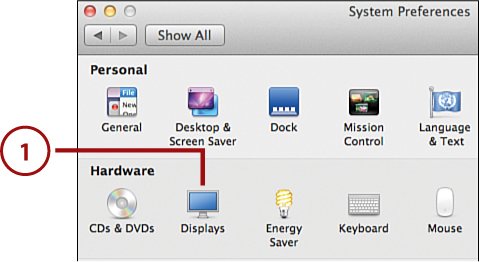
2. Click the Show Displays in Menu Bar checkbox.
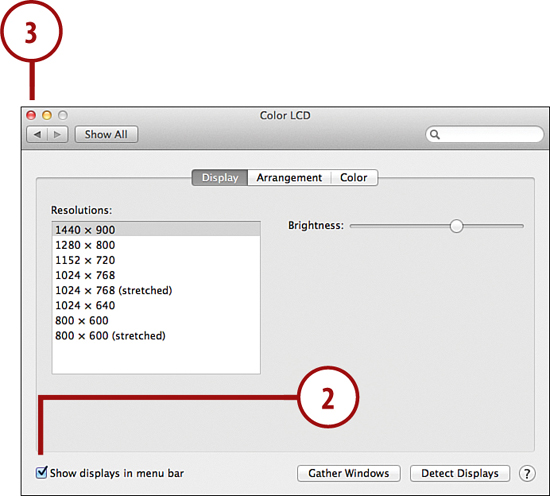
3. Close the System Preferences application.
4. The Displays menu item appears in the menu bar.
![]()
Detecting and Activating a Display
When you plug a display into your computer, you may need to let the system know that it has been connected. To detect and activate a display, follow these steps:
1. Click the Displays menu item in your menu bar.
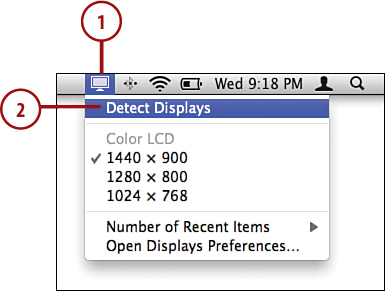
2. Choose Detect Displays from the menu.
3. Your screen might go blank or flash for a moment.
4. The second display activates and is visible in the Displays menu, as well as in the Displays System Preferences Panel.

Setting Monitor Arrangements
Once a monitor has been connected to your system, you can choose how it is arranged in relationship to your MacBook display and whether or not it displays the menu bar.
1. Open the Displays System Preferences Panel.

2. Click the Arrangement button at the top of the screen.
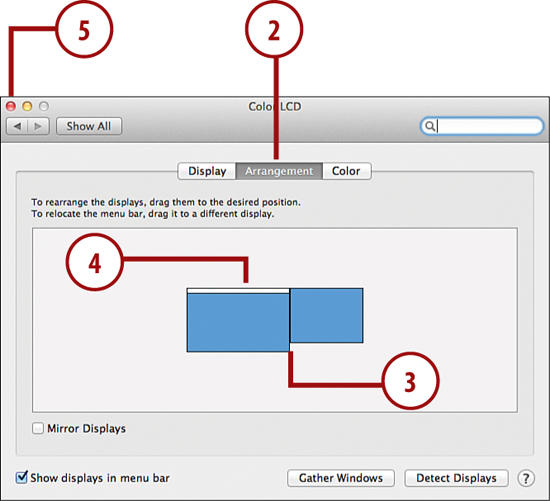
3. Drag the visual representation of the monitors so that it best represents your physical setup (that is, external monitor on the left, right, above, and so on).
4. If you want, change your primary display by dragging the small white line representing the menu bar from one display to the other.
5. Close the System Preferences.
Activating Mirrored Video
If you’d prefer not to use your external display as a second monitor, you can set it to mirror the contents of your MacBook’s LCD.
1. Click the Displays item in your menu bar.
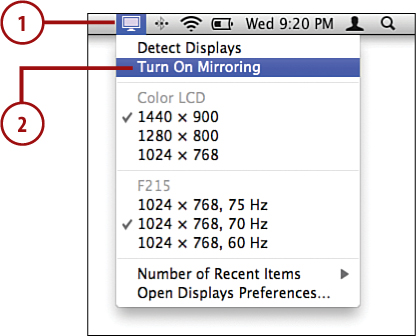
2. Choose Turn on Mirroring from the menu.
3. Your external monitor changes to display the same content as your MacBook’s LCD screen.
4. Choose Turn off Mirroring from the menu to switch back to using two separate displays.
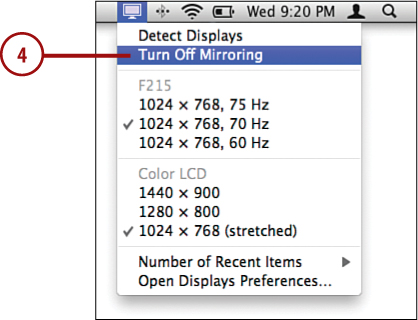
Note
If the external display is set as your primary monitor or cannot be adjusted to match your internal LCD, your MacBook might instead change the resolution on its LCD to match the external monitor. This change reverts when you turn off mirrored video.
Connecting and Using a Printer
Out of the box, Lion supports a range of popular printers just by plugging them in. Occasionally, however, you might need to install a driver before you can successfully print. As with any peripheral that you want to use, be sure to read and follow the manufacturer’s instructions before proceeding.
Adding a Printer
Your MacBook can connect to printers either over a network connection or via a USB direct connection. Regardless of the connection approach, configuration is straightforward.
Setting Up a USB Printer
To connect to a printer via a USB connection, set up the printer as directed by the manufacturer, then follow these steps:
1. Connect the USB plug from the printer to your MacBook and turn on the printer.
2. If the Printer is auto-detected, it may prompt you to download software. Click Install and wait for the installation to complete.

3. Open the System Preferences window and click the Print & Scan icon.
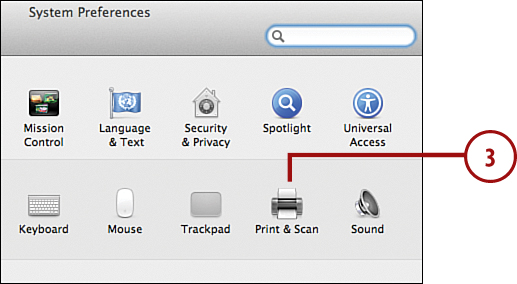
4. In many cases, the printer is detected and configured automatically and is immediately available for use. If this is the case, it is displayed in the Printers list, and you may close the Print & Scan System Preferences panel.
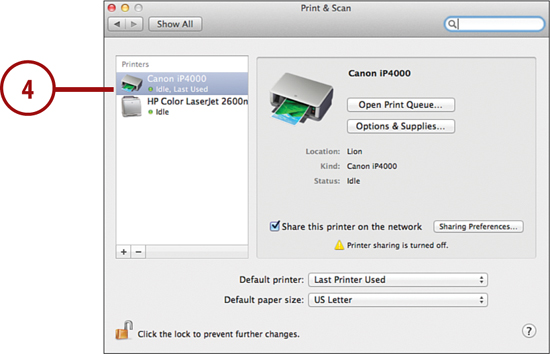
5. If the printer is not detected, click the + button below the Printer list and choose Add Other Printer or Scanner from the popup menu.
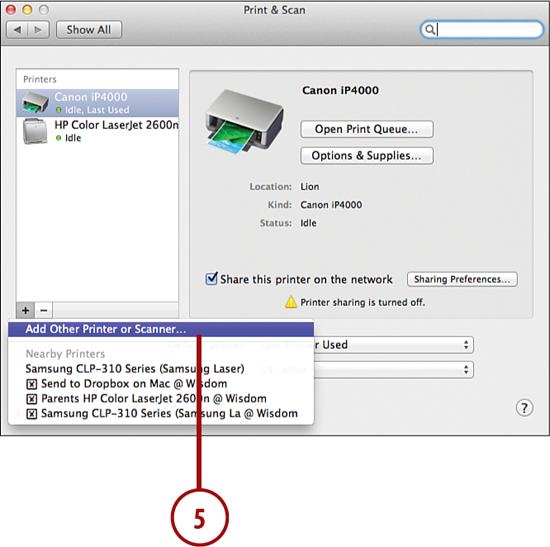
6. A window is shown displaying all of the available printers detected by your Mac. Choose the printer from the list.
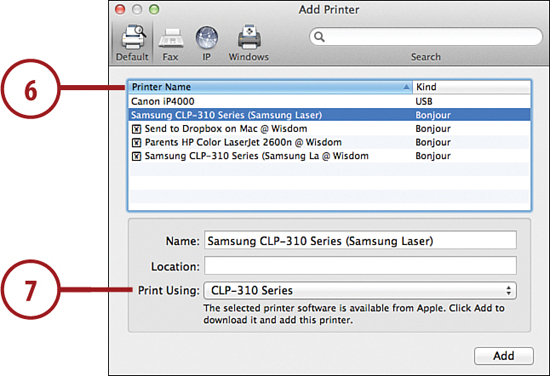
7. Your MacBook searches for the software necessary to use the printer and displays the chosen printer name in the Print Using drop-down menu.
8. If the correct printer name is shown in the menu, jump to Step 12.
9. If the correct printer name is not displayed in the Print Using drop-down menu, choose Select Printer Software from the menu.
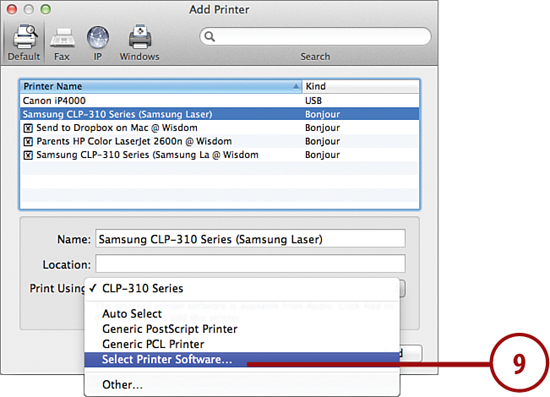
10. A window appears that shows all the printers supported in Lion. Click your printer within the list.
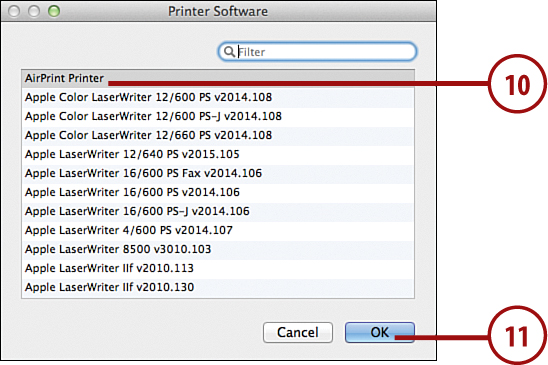
11. Click OK.
12. Click Add to finish adding the printer. If there are options (such as a duplexer) that your MacBook can’t detect, it might prompt you to configure printer-specific features.

13. Close System Preferences and begin using your printer.
The Printing Process
The options available when printing can vary depending on the application that you’re printing from, but once you’re used to the process you’ll be able to find your way around any software’s printing options.
Printing to a Printer
To output to one of your configured printers, complete the following steps in the application of your choice:
1. Choose File, Print from your application’s menu bar.
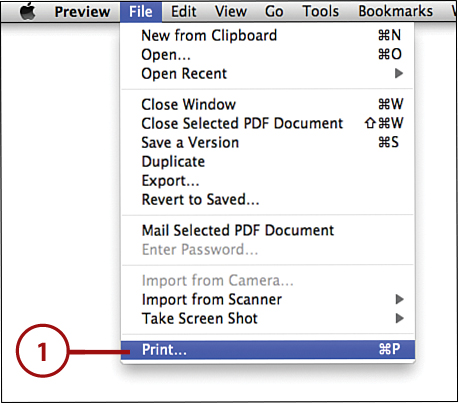
2. Click the Hide/Show Details button to display all the available options, if needed.

3. Select the printer you wish to print to.
4. Set the number of copies and page formatting options.
5. Set the paper size, orientation, and scaling values, if desired.
6. Use the advanced printing options pop-up menu to choose specific printing options for your printer or options related to the application you’re using.
7. Review the results of your settings in the preview area on the left side of the window.
8. Use the controls below the Preview to step through the pages in the document.
9. Use the Presets menu to save your settings if you want to recall them in the future.
10. Click Print to output to the Printer.
Connecting and Using a Scanner
Although it’s not a heavily advertised feature of Lion, the operating system can detect and drive a wide range of scanners without any additional drivers or software. This means that you can connect a scanner to your MacBook and almost immediately begin scanning images.
Adding a Scanner
To connect a USB scanner to your MacBook, complete any initial setup instructions provided in the hardware manual and then follow these steps:
1. Plug the scanner into your MacBook and turn it on.
2. Open the System Preferences window and click the Print & Scan icon.
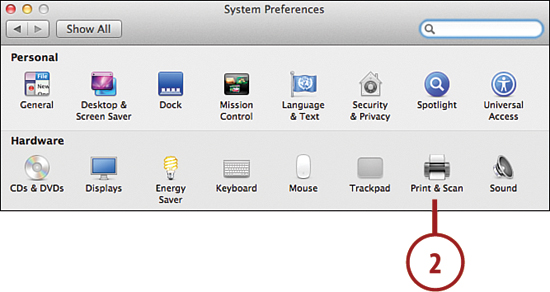
3. The scanner, if supported, appears in the Scanners listing on the left side of the panel.
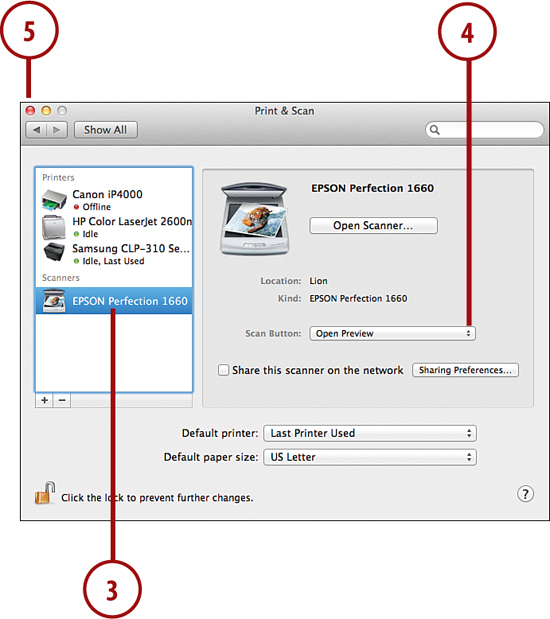
4. Choose the application you want to start when the Scan button is pressed on the scanner. I recommend Preview because it is a convenient application for working with images.
5. Close the Print & Scan System Preferences.
Scanning in Preview
Preview (in the Applications folder, click Preview) serves as the image hub on your MacBook. It views images and PDFs, and allows annotations, cropping, image rotation, and more. With Lion, it can also act as your scanning software. To scan an image directly into Preview, do the following:
1. Open Preview, or press the scan button on the scanner if Preview is set as the default scanning application.
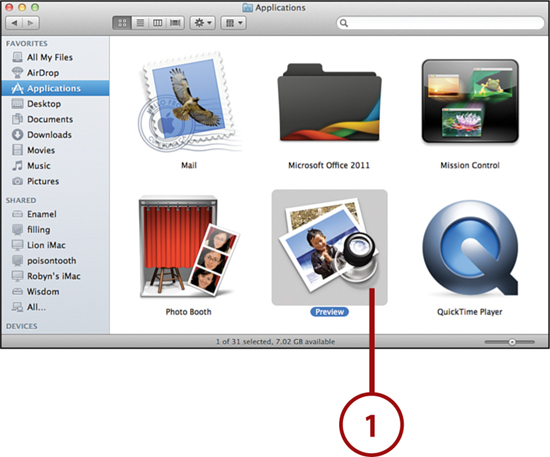
2. Choose Import from Scanner from the File menu and then pick your scanner.
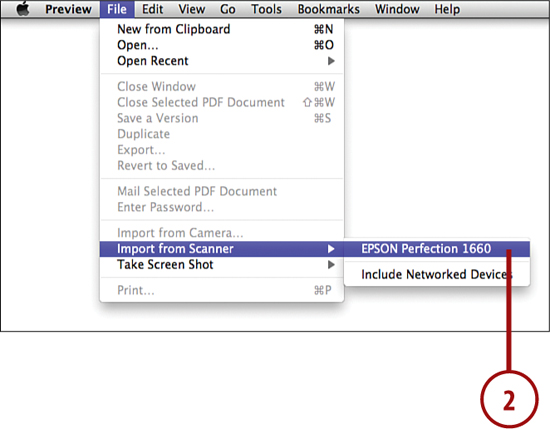
3. The basic scanning window appears. If you want to choose your scanning area or set the resolution, click Show Details and skip to Step 8.
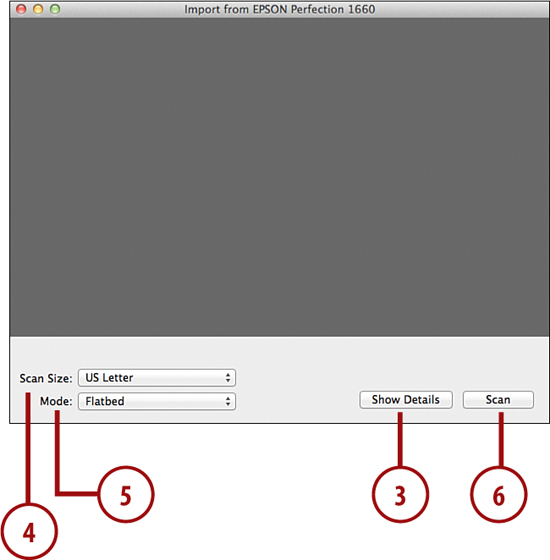
4. Use the Scan Size dropdown to choose the size of the document you’re scanning, or to choose Detect Separate Items to automatically scan individual photos, pictures, and so on into separate images within a single scan.
5. Choose a Mode option: flatbed scanner or transparency scanner.
6. Click Scan. Preview prompts for a save location, performs a detailed scan, and then saves the resulting images in your chosen location.
7. Repeat Step 6 as needed for all of your images.
8. In detailed scanning mode, full controls for the scanner are shown on the right side of the window. Choose the scan’s resolution, size, orientation, and color depth.
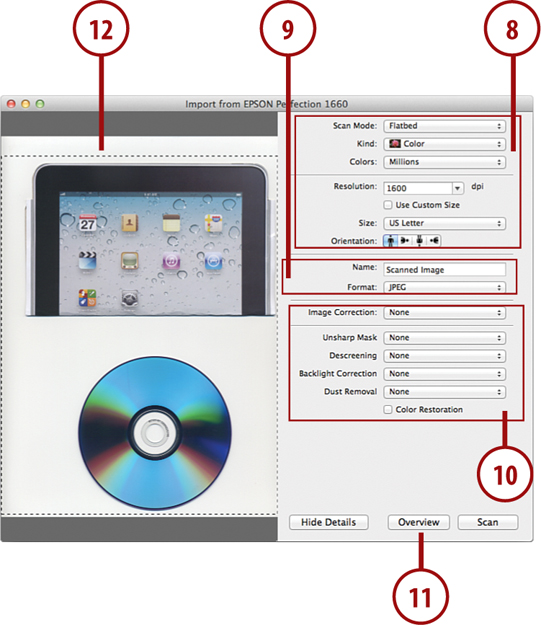
9. Configure the name and format for scanned images.
10. Adjust any image filters and clean-up features you want to apply to the scan.
11. Click Overview to perform a low-resolution scan of your documents and display it in the preview area on the left.
12. Adjust the bounding rectangle to fit your document. If you’ve chosen to detect separate menus, you will see multiple bounding rectangles.
13. Click Scan to prompt for a save location.
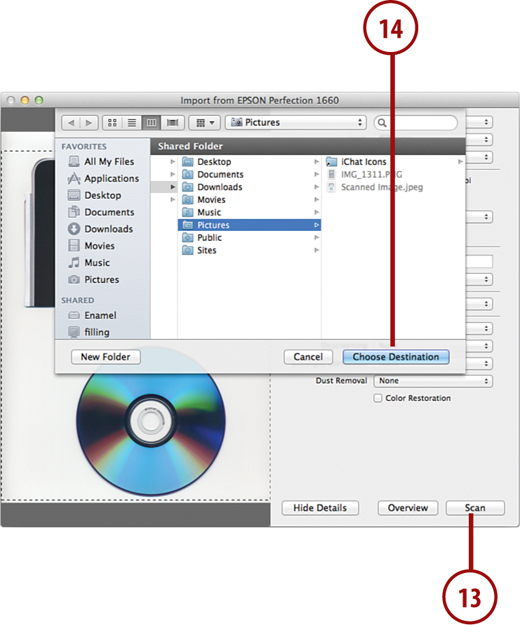
14. Choose your destination, and Lion will scan the document using the settings and the scan region you’ve defined.
